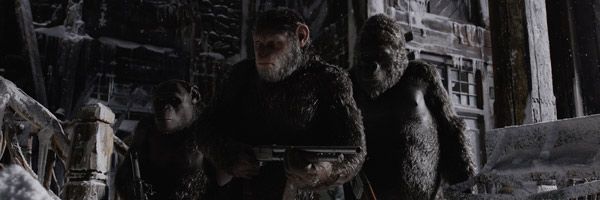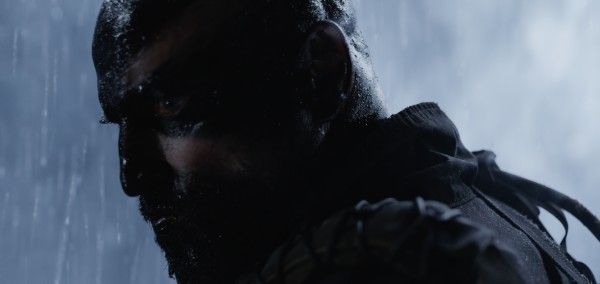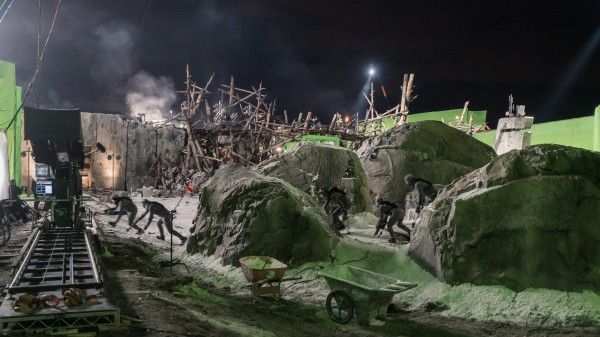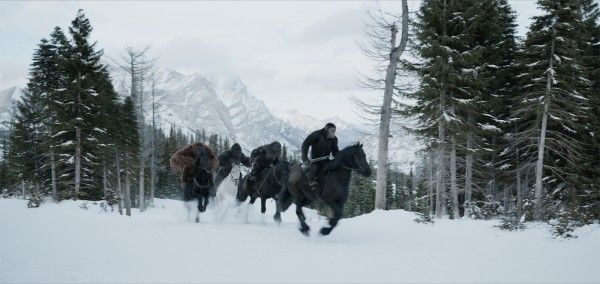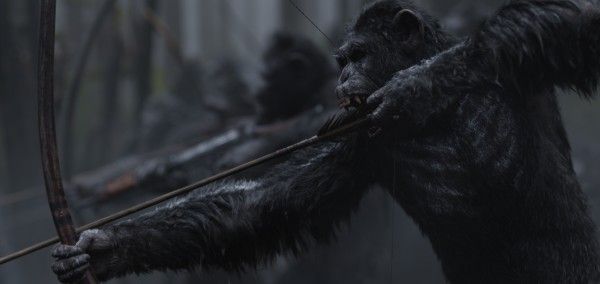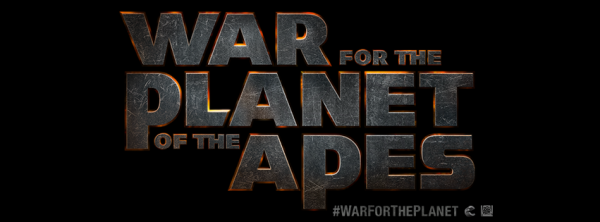(Minor spoilers to follow)
I don’t see the tiny dots glued to Andy Serkis’s face. Nor the tiny camera perched onto his head to capture any facial movements during the shot. To be honest – I barely see Serkis anymore. The actor is transformed, now just Caesar – the heroic if headstrong leader of the genetically evolved apes.
Caesar cries out in pain, his arms strung up onto a misshapen cross, his legs spread and tied beneath. He stares out angrily atop the ‘cross’, grunting at his surrounding human captors. The implication of the image doesn’t hit me until much later on in the day: I just watched Caesar be ‘crucified’.
So War for the Planet of the Apes probably isn’t going to be the feel good movie of the summer – which, to be fair, has always been a hallmark of the Planet of the Apes franchise, a blending of serious socio-political ideas with action movie moxie. Just look at the last film in the Apes franchise: Dawn of the Planet of the Apes – a one-hundred-million-dollar-plus action film about the futility of peace and the sad inevitability of war. There simply isn’t any other franchise so willing to explore as many deep and troubling issues as the Apes saga… And War for the Planet of the Apes may well be the darkest and most timely entry yet.
“This is a much darker, much more brutal, harder, tougher, very brutal film” Andy Serkis confided in between takes on the Vancouver set, “As brutal as you can get within a PG-13. Not in an overly graphic way but in its emotions and context. There's a real sense of foreboding in this movie.”
Two years have passed since the events of Dawn, War for the Planet of the Apes jumping right into the middle of the eponymous war. “If you remember where we left off, the apes had become divided under the leadership of Koba. Caesar was carrying an enormous amount of guilt after going against one of their primary tenets which is that you shall not kill apes.” Serkis revealed, “So two years have passed and the ALZ drug has continued to enable Caesar to develop. He's there now living in a situation where both apes and humans are at war. There's a sense that this is the crux, this is the climactic moment where both species are under huge threat and it's pretty apocalyptic.”
He continued: “They've weathered... both sides are worn out. Caesar's side had to leave their encampment in the woods and move up higher in the hills and set up a temporary base. You'll remember Caesar as a character -- one of his main characteristics, having been brought up with human beings, was to be empathetic to both sides but an event happens at the beginning of this movie that sets him off on a track that almost eats him up…”
Producer Dylan Clark expanded: “Caesar goes on a journey at the end of the first act because he doesn't believe he's fit to lead… He goes on a dark quest because he thinks... Caesar believes if he can kill Woody [Harrelson’s character – the main human antagonist], the apes can win this war and start anew. It doesn't work out that way. Caesar, on his own, gets caught in his own thing…”
“[It’s] a revenge mission after this event happens without giving too much away,” Serkis stated, “He goes through this incredible journey going to the dark heart of himself, probably the darkest he's ever encountered. This voyage of self-destruction… “
It’s not just an emotional journey for Caesar though. Per Serkis: “Physically – he’s much more upright, much more human like. He's continued to evolve linguistically. If you remember in the last movie, the apes were discovering language. They were finding a prototype language and it was a combination of sign and ape vocalizations and the odd human word. For Caesar now, the human word becomes his primary form of expression. So that was a very big challenge for me in terms of charting this next version of Caesar - Caesar Part Three… I think of this movie like 'Boyhood in the Jungle'. We've now come together all these times with all these changes for the character. There are moments that resonate back to the original. Great moments that we've been able to play.”
It’s not all doom and gloom though for Caesar. “I will say this movie is dark -- there are dark elements to it. But there are much lighter elements too.” Dylan Clark stressed, “I think we're trying to find a much better back and forth balance between very impactful emotional drama and how it effects Caesar, but also give entertainment and lighter moments. There's levity... There are more reasons to smile and laugh than there were in prior movies…”
“The set that we're on here is where [Caesar] claws his way back from this very dark place through reconnecting with his tribe who have been holed up and taken prisoner.” Serkis added, “So by the end he's able to redeem himself and to lead the exodus of the apes to freedom once more. It's a fantastic journey. An amazing arc that Matt [Reeves] and Mark Bomback have written. What they've managed to do each time with Dawn and then with this one is to amplify the stakes emotionally and scale-wise. It's on a massive scale not just because of its title... but because the stakes are just so much higher.”
Per Clark: “The real drama is inside Caesar – is [he] going to reclaim [his] morality? [He’s] the most human of all the characters, the most just, the most right… It seems [he’s] lost [his] way a little bit. Can [he] regain it back? That's the suspense and the drama that plays out through the course of [War for the Planet of the Apes].
War for the Planet of the Apes opens July 14, 2017. For the rest of our set visit coverage, peruse the links below.
- Is Koba Really Dead in 'War for the Planet of the Apes'?
- 'War for the Planet of the Apes': How "Apes in Snow" Resulted in Cutting-Edge VFX
- 'War for the Planet of the Apes' Will Explore the Impact of the ALZ Virus on Apes & Humans

